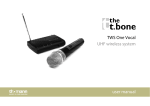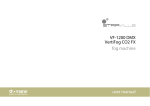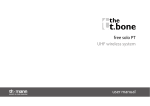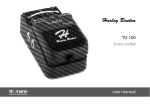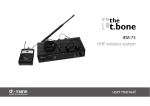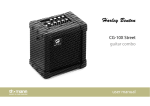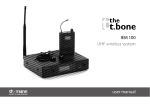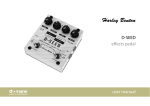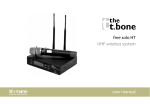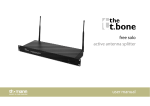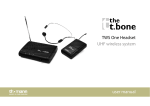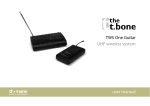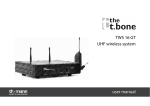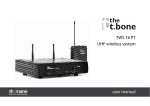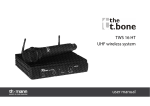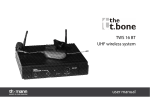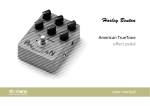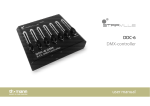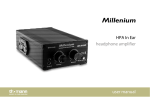Download TWS One Lapel UHF wireless system user manual
Transcript
TWS One Lapel UHF wireless system user manual Musikhaus Thomann Thomann GmbH Hans-Thomann-Straße 1 96138 Burgebrach Germany Telephone: +49 (0) 9546 9223-0 E-mail: [email protected] Internet: www.thomann.de 02.09.2015, ID: 312558 Table of contents Table of contents 1 Safety instructions..................................................................................................................................... 4 2 Features and scope of delivery........................................................................................................... 8 3 Installation and starting up................................................................................................................ 3.1 General Information........................................................................................................................ 3.2 Receiver............................................................................................................................................... 3.3 Transmitter......................................................................................................................................... 4 Connections and operating elements........................................................................................... 15 4.1 Receiver............................................................................................................................................... 15 4.2 Transmitter......................................................................................................................................... 19 5 Technical specifications....................................................................................................................... 21 5.1 Receiver............................................................................................................................................... 21 5.2 Transmitter......................................................................................................................................... 22 6 Plug and connection assignment.................................................................................................... 24 7 Troubleshooting...................................................................................................................................... 26 8 Protecting the environment.............................................................................................................. 29 10 10 11 13 TWS One Lapel 3 Safety instructions 1 Safety instructions Intended use This device is intended to be used for the wireless transmission of audio signals from micro‐ phones or instruments to amplifiers or active speakers. Use the device only as described in this user manual. Any other use or use under other operating conditions is considered to be improper and may result in personal injury or property damage. No liability will be assumed for damages resulting from improper use. This device may be used only by persons with sufficient physical, sensorial, and intellectual abilities and having corresponding knowledge and experience. Other persons may use this device only if they are supervised or instructed by a person who is responsible for their safety. UHF wireless system 4 Safety instructions Safety DANGER! Danger for children Ensure that plastic bags, packaging, etc. are disposed of properly and are not within reach of babies and young children. Choking hazard! Ensure that children do not detach any small parts (e.g. knobs or the like) from the unit. They could swallow the pieces and choke! Never let children unattended use electrical devices. NOTICE! Operating conditions This device has been designed for indoor use only. To prevent damage, never expose the device to any liquid or moisture. Avoid direct sunlight, heavy dirt, and strong vibrations. TWS One Lapel 5 Safety instructions NOTICE! External power supply The device is powered by an external power supply. Before connecting the external power supply, ensure that the input voltage (AC outlet) matches the voltage rating of the device and that the AC outlet is protected by a residual cur‐ rent circuit breaker. Failure to do so could result in damage to the device and pos‐ sibly the user. Unplug the external power supply before electrical storms occur and when the device is unused for long periods of time to reduce the risk of electric shock or fire. NOTICE! Risk of fire due to incorrect polarity Incorrectly inserted batteries may destroy the device or the batteries. Ensure that proper polarity is observed when inserting batteries. UHF wireless system 6 Safety instructions NOTICE! Possible damage by leaking batteries Leaking batteries can cause permanent damage to the device. Take batteries out of the device if it is not going to be used for a longer period. TWS One Lapel 7 Features and scope of delivery 2 Features and scope of delivery The UHF wireless system TWS One Lapel is particularly suitable for professional audio transmis‐ sion, for example, at events, on rock stages and in concert halls, theatres, musicals or discothe‐ ques. Your UHF wireless system TWS One Lapel consists of the following components: n Receiver TWS One R – Adjustable volume – Fixed antenna – Very high sensitivity at very high signal-to-noise ratio – Output: 1/4" phone socket (unbalanced) – Operating supply voltage: DC 12 V n Bodypack transmitter TWS One PT – Suitable for carrying on a belt or for attachment to the guitar strap. – Input: 1/4" phone socket (unbalanced) – Operating supply voltage: 2 AA cells (LR6, 1.5 V) or corresponding rechargeable bat‐ teries n Condenser lavalier microphone PL-90 with wind shield UHF wireless system 8 Features and scope of delivery Included accessories: 12 V power adapter, cable with two 1/4" phone plugs for connection to a mixer or amplifier, two batteries, carrying case The system can be operated free of charge and registration in Europe. Two systems can be operated simultaneously. The transmission range of the system under normal conditions is approximately 50 metres. The system operates at a fixed frequency according to the following table: System description Used frequency (MHz) TWS One A Lapel (item no. 312558) 863.100 MHz TWS One B Lapel (item no. 312559) 863.900 MHz TWS One C Lapel (item no. 312560) 864.500 MHz TWS One D Lapel (item no. 312561) 864.900 MHz TWS One Lapel 9 Installation and starting up 3 Installation and starting up 3.1 General Information Unpack and carefully check that there is no transportation damage before using the unit. Keep the equipment packaging. To fully protect the device against vibration, dust and moisture during transportation or storage use the original packaging or your own packaging material suitable for transport or storage, respectively. Establish all connections as long as the unit is switched off. Use the shortest possible highquality cables for all connections. Notes on radio transmission n This equipment uses a frequency range that is free of charge and registration within the European Union. For more information, please visit: http://www.thomann.de. n Make sure that no metal objects are located between transmitter and receiver. n Avoid interference by other radio and in-ear systems. UHF wireless system 10 Installation and starting up 3.2 Receiver Connecting the power supply NOTICE! External power supply The device is powered by an external power supply. Before connecting the external power supply, ensure that the input voltage (AC outlet) matches the voltage rating of the device and that the AC outlet is protected by a residual cur‐ rent circuit breaker. Failure to do so could result in damage to the device and pos‐ sibly the user. Unplug the external power supply before electrical storms occur and when the device is unused for long periods of time to reduce the risk of electric shock or fire. First, connect the power adapter to the receiver and then plug the power adapter into the power outlet. TWS One Lapel 11 Installation and starting up Connecting audio and starting up Connect the audio output of the receiver to your mixer or your amplifier. Set the volume control first as follows: n If you are using a microphone input of your mixer, turn the knob to about 1 o'clock. n If you are using a line input of your mixer, turn the knob clockwise all the way to the stop. To get the best sound quality, a fine adjustment of the controller may be required. UHF wireless system 12 Installation and starting up 3.3 Transmitter Inserting batteries into the receiver 1. Make sure that the transmitter is turned off, the main switch is in ‘OFF’ position. 2. Open the battery compartment cover by pressing on the side latches. 3. Insert the batteries. Pay attention to the correct location of the poles. 4. Close the battery compartment and turn on the transmitter. Slide the power switch to the 'ON' position. The LED lights up briefly. TWS One Lapel 13 Installation and starting up Connecting the microphone to the transmitter 1. Make sure that the transmitter is turned off, the main switch is in ‘OFF’ position. 2. Plug the 3.5 mm phone plug of the microphone into the input socket of the transmitter. 3. Turn on the transmitter and check the transmission by speaking of singing. If necessary, toggle the sensitivity switch on the transmitter or adjust the level on the receiver, your mixer or your amplifier. UHF wireless system 14 Connections and operating elements 4 Connections and operating elements 4.1 Receiver Front panel TWS One Lapel 15 Connections and operating elements 1 Rotatable and swivelling antenna. 2 [VOLUME] Output level control. 3 [AUDIO] The indicator lights green when an audio signal is received. 4 [RF] The LED lights orange when a radio connection to the transmitter is present. 5 [POWER] The LED lights red when the unit is powered on and ready for use. UHF wireless system 16 Connections and operating elements Rear panel TWS One Lapel 17 Connections and operating elements 1 Rotatable and swivelling antenna. 6 [DC IN] Socket for connecting the supplied AC adapter. If you are using a different power supply, observe the correct voltage, the polarity of the plug and the power consumption. 7 [AUDIO OUT] 1/4" phone socket as unbalanced audio signal output for direct connection to a mixer, an amplifier or recording device. UHF wireless system 18 Connections and operating elements 4.2 Transmitter TWS One Lapel 19 Connections and operating elements 8 Indicator LED Displays the state of the batteries. If you turn on the transmitter, the LED lights up briefly, indicating that the batteries still provide sufficient voltage. When the LED lights continuously, the batteries are exhausted. In this case, you should replace the batteries or charge the rechargeable batteries. 9 Antenna. 10 Main switch. Turns the unit on (‘ON’), mute (‘STANDBY’) or completely off (‘OFF’). 11 Sensitivity selector switch with following positions: n [MIC]: Suitable for microphones n [0dB]: Suitable for guitars with passive pickups n [-10dB]: Suitable for guitars with active pickups 12 3.5mm phone socket (mono) for the microphone or instrument cable. 13 Indicating the frequency range in which the device operates. The indication here must match the information on the bottom of the receiver. 14 Retaining clamp. 15 Battery compartment for 2 AA cells (LR6, 1.5 V) or appropriate rechargeable batteries. UHF wireless system 20 Technical specifications 5 Technical specifications 5.1 Receiver Output 1/4" phone socket (unbalanced) Output Level (@ a 3 kΩ load) -18 dBV Output impedance 1 kΩ Carrier frequency UHF band (863…865 MHz) Modulation type Frequency modulation (FM) Transmission range under normal conditions approx. 50 m Signal-to-noise ratio > 92 dB Side and image frequency rejection 90 dB min. NF frequency response 60 Hz…16 kHz (±3 dB) THD <1% TWS One Lapel 21 Technical specifications Dynamic range > 90 dB (A-weighted) Operating supply voltage DC 12 V Dimensions (W × D × H, without antenna) 150 mm × 118 mm × 35 mm Weight 180 g 5.2 Transmitter Input 3.5 mm Phone plug Input impedance 470 kΩ Carrier frequency UHF band (863…865 MHz) Modulation type Frequency modulation (FM) Transmission power 10 dBm Operating supply voltage 2 AA cells (LR6, 1.5 V) or corresponding rechargeable batteries UHF wireless system 22 Technical specifications Battery life span >8h Dimensions (W × D × H, without antenna) 65 mm × 23 mm × 105 mm Height with antenna 170 mm Weight (without batteries) 77 g TWS One Lapel 23 Plug and connection assignment 6 Plug and connection assignment Introduction This chapter will help you select the right cables and plugs to connect your valuable equip‐ ment in such a way that a perfect sound experience is ensured. Please note these advices, because especially in ‘Sound & Light’ caution is indicated: Even if a plug fits into the socket, an incorrect connection may result in a destroyed power amp, a short circuit or ‘just’ in poor transmission quality! Balanced and unbalanced trans‐ mission Unbalanced transmission is mainly used in semi-professional environment and in hifi use. Instrument cables with two conductors (one core plus shielding) are typical representatives of the unbalanced transmission. One conductor is ground and shielding while the signal is trans‐ mitted through the core. Unbalanced transmission is susceptible to electromagnetic interference, especially at low levels, such as microphone signals and when using long cables. In a professional environment, therefore, the balanced transmission is preferred, because this enables an undisturbed transmission of signals over long distances. In addition to the conduc‐ tors ‘Ground’ and ‘Signal’, in a balanced transmission a second core is added. This also transfers the signal, but phase-shifted by 180°. UHF wireless system 24 Plug and connection assignment Since the interference affects both cores equally, by subtracting the phase-shifted signals, the interfering signal is completely neutralized. The result is a pure signal without any noise inter‐ ference. 1/4" TS phone plug (mono, unbalanced) 1 Signal 2 Ground 1 Signal 2 Ground, shielding 1/4" TS phone plug (mono, unbalanced) TWS One Lapel 25 Troubleshooting 7 Troubleshooting In the following we list a few common problems that may occur during operation. We give you some suggestions for easy troubleshooting: UHF wireless system 26 Troubleshooting Symptom Remedy No sound 1. Check the power supply of transmitter and receiver. 2. Make sure that transmitter and receiver are operating in the same frequency range. The frequency can be found on the devices. 3. Test the connection between the receiver and the connected audio device (amplifier, mixer). Is the connected audio device turned on and does the signal level at the output of the receiver match the input requirements of the audio device? 4. See if the audio transmission works when you move the transmitter closer to the receiver. 5. Make sure that no metal objects near the transmitter or receiver obstruct the transmission. Transmission is interrupted. 1. Change the orientation of the antenna. 2. If you use more than one wireless system at the same time, check the used frequencies and channels. TWS One Lapel 27 Troubleshooting Symptom Remedy 3. Interference can also be caused by televisions, radios or mobile phones. The sound is distorted. Toggle the sensitivity selector switch on the transmitter of change the setting of the controller [VOLUME on the receiver]. If the procedures recommended above do not succeed, please contact our Service Center. You can find the contact information at www.thomann.de. UHF wireless system 28 Protecting the environment 8 Protecting the environment Disposal of the packaging mate‐ rial For the transport and protective packaging, environmentally friendly materials have been chosen that can be supplied to normal recycling. Ensure that plastic bags, packaging, etc. are properly disposed of. Do not just dispose these materials with your normal household waste, but make sure that they are fed to a recovery. Please follow the notes and markings on the packaging. Disposal of batteries Batteries must not be disposed of as domestic waste or thrown into fire. Dispose of the bat‐ teries according to national or local regulations regarding hazardous waste. To protect the environment, dispose of empty batteries at your retail store or at appropriate collection sites. TWS One Lapel 29 Protecting the environment Disposal of your old device This product is subject to the European Waste Electrical and Electronic Equipment Directive (WEEE). Do not dispose with your normal household waste. Dispose this device through an approved waste disposal firm or through your local waste facility. When discarding the device, comply with the rules and regulations that apply in your country. If in doubt, consult your local waste disposal facility. UHF wireless system 30 Musikhaus Thomann · Hans-Thomann-Straße 1 · 96138 Burgebrach · Germany · www.thomann.de
































